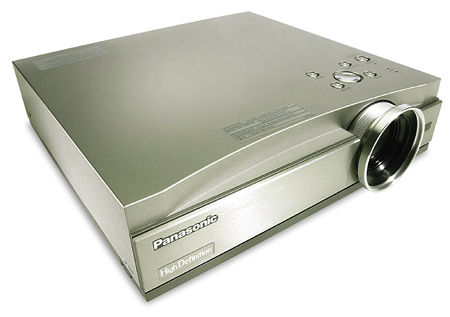Panasonic PT-AE500U LCD video projector

Back to the present: Front LCD projectors for home theater are no big deal—there are several models to choose from, and prices have dropped considerably as competition from single-chip DLP technology has stepped up. In fact, the majority of front projectors for home theater use DLP technology, but there are a few LCD stalwarts, most notably Sanyo, Panasonic, Mitsubishi, Hitachi, and (of course) Sony. As of this writing, Mitsubishi and Hitachi offer inexpensive front LCD projectors with what's known as "quarter HD" resolution: 964x544. In contrast, the current Panasonic, Sanyo, and Sony LCD offerings take the technology to a higher level with Wide XGA LCD panels.
This review focuses on Panasonic's PT-AE500U ($2495), the latest model from the Matsushita factory. It has three 1280x720 LCD panels and comes with a great deal of buzz about its color and image quality—at least, from those who saw a preview of it at last year's CEDIA Expo.
Out of the Box
The PT-AE500U doesn't look like much—a clean, compact design that tips the scales at just over six pounds. The housing is a very attractive silver color, with the lens offset to the side. The watchword here is simplicity.
Panasonic has provided a reasonable complement of connectors, starting with the basics: one composite input, one S-video input, and a three-wire RCA component hookup. Got RGB? There's a 15-pin VGA jack for connection to anything from set-top receivers to your PC. Got DVI? Panasonic has included that, too, and it supports HDCP. There's even a 12VDC screen trigger connection.
I don't understand why no component-video cable is supplied with this projector. Nor is the PT-AE500U alone in this regard—I've tested several lower-priced front projectors that offer component inputs but don't provide a basic Y-Pb-Pr accessory cable. [This shortcoming is true of every front projector I've seen—even very expensive ones. Perhaps it's because the cable length needed by a buyer can't be anticipated by the manufacturer.—Ed.]
The supplied remote control is a bit small (most of them are for me), but it has a nice layout with logical button positioning. You navigate through menus with up/down and left/right arrows and a central Enter key. Fortunately, Panasonic did not employ a joystick for navigation—they tend to be imprecise and a nuisance to use. You can access any input directly with the remote—no need to sequence through unused inputs.
The supplied lens has short zoom ratio (about 1.2:1), which gives you little room for positioning. There's also a slight positive image offset so that most of the image clears the top of the projector. This leads me to think that the PT-AE500U was intended for casual "coffee-table" service.
The PT-AE500U was very quiet; I could hardly tell that it was operating. Panasonic specs the fan noise at 27dB, which means that if you mount it on the ceiling, you won't hear it at all. There are no internal speakers—you'll need external audio reinforcement for use outside a home theater.
Operation and Menus
I found the menus easy to navigate, although individual ad- justment submenus don't stay on the screen for long. Full control is provided over image parameters. Of particular interest are Gamma settings for each color channel (RGB), plus RGB Contrast ("drive," for you CRT veterans) and RGB Brightness ("bias," for the tube crowd).
As a result, there's a lot of fiddling you can do with image quality, although Panasonic also provides some preset modes for Gamma, Brightness, Contrast, and Color Temperature. These are identified as Normal, Dynamic, Video, Natural, and Cinema 1 and 2. I set up the projector in Normal mode before making any adjustments to Gamma, Contrast, and Brightness.
According to Panasonic, their engineers worked with top Hollywood post-production film colorists to achieve a filmlike gamma, along with a more accurate color palette. (The Cinema 1 mode, in particular, was finalized in cooperation with these experts.) Ten-bit sampling is used to produce 1024 luminance shades for red, green, and blue, which enhances the PT-AE500U's ability to reproduce subtle color shades.
Another enhancement, called Smooth Screen, is a technique to minimize the LCD screen-door effect by double refraction of images within each pixel. I don't have any details on how Panasonic accomplished this; all I can say is that the screen-door effect wasn't completely eliminated—but it wasn't as noticeable as on other LCD models I've tested.
Three picture memories are provided, though one or two more would have been better. When I played 480i or 480p material, only two memories showed up as options; switching to HD input signal sources gave me access to all three memory selections. Five aspect-ratio presets are available with 408i/p programs, while HD signals are restricted to the 16:9 ratio.




























































